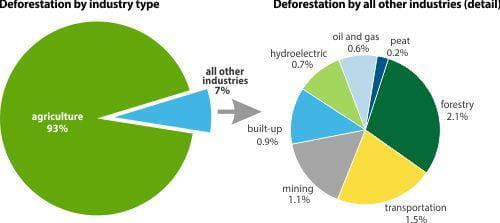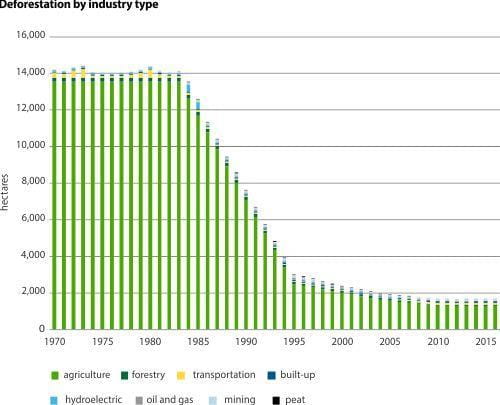
Deforestation is the permanent conversion of forests to other land uses through human activity. The loss of forest area through deforestation reduces biodiversity, decreases wildlife habitat and impacts soil and water quality. Increasing forest area through afforestation helps to offset these losses. Canada's deforestation rate is among the lowest in the world.
What's happening

What we are doing
Monitoring deforestation provides a means of tracking land conversion, trends and assessing human impacts on ecosystem health. Understanding the rate of deforestation also supports the federal target to cut forest loss in half by 2020, and reduce net deforestation to zero by 2030.
Afforestation was not measured during this reporting period. However, afforestation activities in Saskatchewan include planting agriculture lands with trees for shelterbelts and agroforestry purposes.
Deforestation in Saskatchewan is primarily calculated by extracting provincial data from summaries supplied by the National Deforestation Monitoring System (NDMS) of Natural Resources Canada. Supplemental information about larger disturbances in the north was incorporated to calculate the total provincial deforested area.

Natural disturbances such as wildfire, and human-caused disturbances such as harvesting, do not result in deforestation because a new forest will grow back in its place.

Most of the deforestation in Saskatchewan between 1970 and 2016, about 314,495 hectares (94 per cent), can be attributed to agricultural practices. This deforestation occurs within the Prairie and the Boreal Plain ecozones. Agriculture-related deforestation in these ecozones has decreased significantly since 1970, to 1,299 hectares per year in 2016.
The greatest amount of deforestation in a single ecozone has occurred in the Boreal Plain. While most commercial forest activities occur within this ecozone, agriculture has been the primary cause of deforestation. Since 1970, an estimated 213,544 hectares have been deforested within this ecozone, accounting for 63 per cent of the overall area deforested in Saskatchewan. Deforestation rates in the Boreal Plain have significantly declined in the past decade, down to 1,246 hectares per year in 2016, and are expected to continue on a downward trend.
Urban and industrial development make up 17,122 hectares (3.5 per cent) of deforestation in the province. This includes: transportation, hydroelectric infrastructure and reservoirs; oil and gas; mining; and recreational, industrial, institutional and commercial development.
The forestry sector's contribution to deforestation is limited to the construction of permanent access roads. All area harvested is required to be reforested, and is surveyed to confirm that regrowth is occurring at the rate expected. The majority of forest access roads are temporary and are reclaimed (brought back to forest). The remaining permanent access roads account for two per cent of the overall deforestation in Saskatchewan between 1970 and 2016.
Peat harvesting represents a small fraction of deforestation in Saskatchewan, with typical levels of less than 30 hectares per year. Recent environmental impact assessments indicate a renewed interest in peat mining projects within the provincial forest. The annual deforestation levels expected from these new developments are not likely to exceed normal amounts.
Why it matters
The annual rate of deforestation across the entire province has drastically declined since the 1970s and has remained fairly constant in the last 10 years at 1,721 hectares per year. It is important that deforestation is limited in the provincial forest to ensure a sustainable forest industry with wildlife habitat protection, ecosystem stability and carbon storage.
Forests in Saskatchewan are important for recreation and tourism opportunities, provide raw materials to the forest industry and host mining and oil and gas industries, all of which are important contributors to the provincial economy. The conversion of forested land for agriculture, mining, forest roads and other industrial use provides economic opportunities for residents of Saskatchewan, but must be managed in a sound and sustainable manner to help ensure the long-term use and function of the provincial forest.




